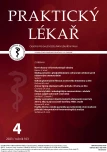. Lifestyle of children with oncological diseases in remission and their healthy peers
Authors:
T. Vyhlídal; F. Chmelík
Authors‘ workplace:
Univerzita Palackého v Olomouci Fakulta tělesné kultury Děkan: Mgr. Michal Šafář, Ph. D.
Published in:
Prakt. Lék. 2023; 103(4): 188-194
Category:
Of different specialties
Overview
Background: The lifestyle of children with oncological diseases can exert a profound influence on their long-term health outcomes, primarily due to the potential emergence of late treatment-related effects.
Objective: This study aimed to characterize the lifestyle of children with oncological diseases during the remission period, while also assessing differences in lifestyle between children in remission and their healthy peers. Additionally, we sought to evaluate these differences while considering the factor of gender among the participants.
Methods: The research sample comprised a total of 60 subjects, divided into a research group and a control group. The research group consisted of 23 children in remission who underwent active oncological treatment at the Department of Pediatric Oncology, University Hospital in Brno. The control group consisted of their 37 healthy peers. Data collection was performed using a questionnaire constructed from standardized items focusing on the lifestyle of children and adolescents, as utilized in the international study, Health Behaviour of School-Aged Children.
Result: Overall, children with oncological diseases in remission did not exhibit significant differences in lifestyle compared to their healthy peers. However, a subgroup analysis among boys revealed notable distinctions between the studied groups.
Conclusions: These findings suggest the importance of considering gender when designing intervention and educational programs related to the lifestyle of children with oncological diseases in remission.
Keywords:
sleep – Physical activity – lifestyle – nutrition – pediatric cancer – screen time
Sources
- Krejčí D, Ščavnický J, Zapletalová M, a kol. Czech Childhood Cancer Information Systém [online]. Dostupné z: https://ccc-is. uzis.cz [cit. 2023-05-30].
- Smith WA, Li C, Nottage KA, et al. Lifestyle and metabolic syndrome in adult survivors of childhood cancer: a report from the St. Jude Lifetime Cohort Study. Cancer. 2014; 120(17): 2742–2750.
- Langer T, Grabow D, Steinmann D, et al. Late effects and longterm follow-up after cancer in childhood. Oncol Res Treat. 2017; 40(12): 746–750.
- Rueegg CS, Kriemler S, Zuercher SJ, et al. A partially supervised physical activity program for adult and adolescent survivors of childhood cancer (SURfit): study design of a randomized controlled trial [NCT02730767]. BMC Cancer. 2017; 17: 1–15.
- Demark‐Wahnefried W, Werner C, Clipp EC, et al. Survivors of childhood cancer and their guardians: current health behaviors and receptivity to health promotion programs. Cancer. 2005; 103(10): 2171–2180.
- Götte M., Taraks S, Boos J. Sports in pediatric oncology: the role(s) of physical activity for children with cancer. J Pediatr Hematol Oncol. 2014; 36(2): 85–90.
- Kopp LM, Gupta P, Pelayo-Katsanis L, et al. Late effects in adult survivors of pediatric cancer: a guide for the primary care physician. Am J Med. 2012; 125(7): 636–641.
- van Dijk‐Lokkart EM, Steur LM, Braam KI, et al. Longitudinal development of cancer‐related fatigue and physical activity in childhood cancer patients. Pediatr Blood Cancer. 2019; 66(12): e27949.
- Fiuza-Luces C, Padilla JR, Soares-Miranda L, et al. Exercise intervention in pediatric patients with solid tumors: the physical activity in pediatric cancer trial. Med Sci Sports Exerc. 2017; 49(2): 223–230.
- Klimešová I, Stelzer J, Miklánková L. Family Eating and Activity Habits Questionnaire-český překlad a ověření srozumitelnosti dotazníku. Čes-slov Pediat. 2018; 73(8): 494–450.
- Klimešová I, Elfmark M, Králová P. Stravovací a pohybové zvyklosti v rodině-ověření reliability dotazníku. Čes-slov Pediat. 2020; 75(2): 78–81.
- Chaput JP, Katzmarzyk PT, LeBlanc AG, et al. Associations between sleep patterns and lifestyle behaviors in children: an international comparison. Int J Obes Suppl. 2015; 5(Suppl 2): 59–65.
- Health Behaviour in School-aged Children (HBSC). Mezinárodní výzkumná studie o zdraví a životním stylu dětí a školáků [online]. Dostupné z: https://hbsc.cz/ [cit. 2023-05-30].
- Chaput JP, Willumsen J, Bull F, et al. 2020 WHO guidelines on physical activity and sedentary behaviour for children and adolescents aged 5–17 years: summary of the evidence. Int J Behav Nutr Phys Act. 2020; 17(1): 141.
- Tremblay MS, Carson V, Chaput JP, et al. Canadian 24-hour movement guidelines for children and youth: an integration of physical activity, sedentary behaviour, and sleep. Appl Physiol Nutr Metab. 2016; 41(6 Suppl 3): S311–S327.
- Paruthi S, Brooks LJ, D‘Ambrosio C, et al. Recommended amount of sleep for pediatric populations: a consensus statement of the American Academy of Sleep Medicine. J Clin Sleep Med. 2016; 12(6): 785–786.
- Campbell I. Chi‐squared and Fisher–Irwin tests of two‐by‐two tables with small sample recommendations. Stat Med. 2007; 26(19): 3661–3675.
- Richardson JT. The analysis of 2× 2 contingency tables – yet again. Stat Med. 2011; 30(8): 890–890.
- Gába A, Baďura P, Dygrýn J, a kol. Národní zpráva o pohybové aktivitě českých dětí a mládeže 2022 [online]. Dostupné z: https://activehealthykids.upol.cz/narodni-zprava-2018 [cit. 2023-05-30].
- Kalman M, Baďura P, Veškrnová K, a kol. Zdravá generace. Zkoumáme životní styl českých dětí [online]. Dostupné z: https:// zdravagenerace.cz/ [cit. 2023-05-30].
Labels
General practitioner for children and adolescents General practitioner for adultsArticle was published in
General Practitioner

2023 Issue 4
Most read in this issue
- New horizons in the drug treatment of obesity
- Estimation of glomerular filtration rate from serum creatinine in children
- Armeo Spring improves quality of movement and quality of life after stroke
- Food components with presumed anticancer effects
